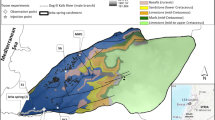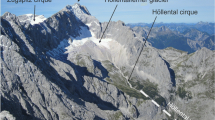Abstract
A reservoir approach to analyzing tracer transport in steady-state karstic groundwater systems is evaluated. Tracer transport is dictated by a central flow system made up of a series of reservoirs or pools. These reservoirs may also have a ‘side capacity’ that represents less integrated hydraulic features that act to delay tracer as it moves through the system. The composite system results in a relatively extended tracer signal following a rapid first arrival, a behavior often observed in tracer experiments performed in karst. The reservoir model is an alternative to the often-used advection-dispersion model augmented with a first-order exchange between mobile and immobile fractions of the flow system (the MIM model). A well-known field tracer test is revisited using both the reservoir and MIM approach. The reservoir model indicates that ‘immobile’ zones actually represent only a small delay in tracer transport, but these delays, in sum, lead to a significant tail on the breakthrough curve. It is suggested that a reservoir analysis of tracer breakthrough in karst systems may be more relevant to physical descriptions of karstic groundwater systems than models such as MIM, which are based upon solute transport in porous media.
Résumé
Une approche réservoir destinée à analyser le transfert d’un traceur dans un système d’écoulement karstique non évolutif est évaluée. Le transfert du traceur est contrôlé par un système d’écoulement central constitué d’une série de réservoirs ou biefs. Ces réservoirs peuvent aussi avoir « un effet capacitif » qui explique des comportements hydrauliques moins intégrés contribuant à retarder le traceur lorsqu’il se déplace dans le système. Le système composite délivre un signal de traçage relativement prolongé venant à la suite d’une percée rapide, comportement souvent observé dans des expériences de traçage effectuées sur le karst. Le modèle réservoir est une alternative au modèle souvent utilisé d’advection-dispersion complémenté d’un échange de premier ordre entre les fractions mobiles et immobiles du système d’écoulement (le modèle MIM). Un test bien connu de traçage sur le terrain est repris en utilisant à la fois l’approche réservoir et l’approche MIM. Le modèle réservoir indique que les zones « immobiles » correspondent de fait à seulement un petit retard dans le transfert du traceur, mais les retards conduisent au total à une traînée significative de la courbe réponse du signal. On suggère qu’une analyse réservoir de la percée du traceur dans les systèmes karstiques est peut être plus adaptée à une description physique de ces systèmes que les données de modèles tels MIM de type MIM, basés sur le transport de solutés en milieux poreux.
Resumen
Se evalúa un enfoque de reservorio para analizar el transporte de un trazador en un sistema kárstico de agua subterránea en estado estacionario. El transporte de trazador está dictado por un sistema de flujo central compuesto por una serie de reservorios o cuerpos de agua. Estos reservorios pueden también tener una capacidad lateral que representa aspectos hidráulicos menos integrados que actúan retardando el trazador a medida que se mueve a través del sistema. Los sistemas compuestos resultan de una señal relativamente prolongada del trazador después de una primera llegada rápida, con un comportamiento a menudo observado en las experiencias con trazadores realizados en karst. El modelo de reservorio es una alternativa al uso frecuente del modelo de advección-dispersión aumentado con un intercambio de primer orden entre las fracciones móviles e inmóviles del sistema de flujo (el modelo MIM). Una prueba de campo bien conocida de trazadores es reexaminada usando tanto la aproximación de reservorio como la MIM. El modelo de reservorio indica que zonas “inmóviles” representan en realidad solo un pequeño retardo en el transporte del trazador, pero estos retardos, en suma, conducen a una cola significativa en la curva de ruptura. Se sugiere que un análisis de reservorio de la curva de ruptura del trazador en sistemas kársticos puede ser más relevante para las descripciones físicas de sistemas de aguas subterráneas kársticos que modelos tales como MIM, que están basados sobre el transporte de solutos en medios porosos.
摘要:
本文评价了对稳定状态岩溶地下水系统示踪进行分析的一种水库模型。示踪传输是由一系列在中心水流系统中水库或坑塘形成的。这些水库具有侧向容量,表现为不完整的水力特征导致示踪剂在系统中移动的延迟。这一综合系统形成相对扩展的流动示踪信号迅速到达,反应了在岩溶示踪试验中常见的特征。水库模型可以与常用的对流-弥散模型(MIM模型)在系统中可移动和不可移动组份之间一级交换作对比。用众所周知野外示踪试验重现水库模型和MIM模型。水库模型显示出不可移动的组份在运移中仅有少量的延迟,但合并这些延迟导致了在穿透曲线中明显的拖尾。建议是:相比建立在孔隙介质中溶质运移的MIM模型,水库模型分析岩溶系统中的示踪穿透的描述会更接近岩溶地下水系统的特征。
Riassunto
Il trasporto di un tracciante in un sistema carsico in condizioni di flusso stazionarie è stato analizzato mediante un approccio a serbatoi. Il trasporto del tracciante è controllato da un sistema composto da serbatoi o volumi di accumulo disposti in serie. Questi serbatoi possono avere anche una ‘capacità laterale’, la quale rappresenta elementi idraulici non ben integrati nel sistema che agiscono ritardando il tracciante mentre si muove attraverso il sistema. Il sistema così composto dà luogo ad un segnale relativamente esteso che fa seguito ad un rapido picco di tracciante; un andamento che spesso si osserva negli esperimenti con traccianti condotti nei sistemi carsici. Il modello a serbatoi è una possibile alternativa al modello di avvezione-dispersione con scambio del primo ordine fra le frazioni immobile e mobile del flusso, spesso utilizzato nelle applicazioni (modello MIM). In questo contributo un ben noto esperimento di campo è stato rivisitato utilizzando sia il modello a serbatoi, che il modello MIM. Il modello a serbatoi mostra come queste zone “immobili” introducano singolarmente in piccolo ritardo che però sommato a tutti gli altri porta alla formazione di una significativa coda della concentrazione di flusso in uscita dal sistema. Questo porta a suggerire come un’adeguata analisi con il metodo dei serbatoi di esperimenti con traccianti può portare nei sistemi carsici ad una descrizione dei processi di trasporto migliore di quanto si possa fare con i modelli MIM, basati sull’ipotesi che esista una analogia con il trasporto nei mezzi porosi.
Resumo
Neste trabalho é avaliada a abordagem a um reservatório para analisar o transporte de traçadores em sistemas cársicos de água subterrânea em estado estacionário. O transporte de traçadores é ditado por um sistema de fluxo central constituído por uma série de reservatórios. Estes reservatórios podem ter também uma ‘capacidade secundária’ que representa caraterísticas hidráulicas menos integradas que atuam para retardar o traçador enquanto este se move no sistema. O sistema compósito conduz a um sinal do traçador relativamente extenso, após uma primeira chegada rápida, o que corresponde a um comportamento muitas vezes observado em ensaios de traçadores feitos em sistemas cársicos. O modelo de reservatório é uma alternativa ao modelo de adveção–dispersão, muitas vezes usado, melhorado com um intercâmbio de primeira ordem entre frações móveis e imóveis do sistema de fluxo (o modelo MIM, mobile–immobile model). Um ensaio de traçador bem conhecido é revisitado usando a abordagem de reservatório e o MIM. O modelo de reservatório indica que as zonas ‘imóveis’ representam de facto apenas um pequeno atraso no transporte do traçador, mas estes atrasos somados conduzem a uma cauda significativa na curva de chegada. Sugere-se que uma análise, baseada na abordagem do reservatório, da curva de chegada do traçador em sistemas cársicos, possa ser mais relevante nas descrições físicas dos sistemas cársicos de água subterrânea do que os modelos como o MIM, que são baseados em transporte de solutos em meios porosos.






Similar content being viewed by others
References
Anwar S, Sukop MC (2009) Lattice Boltzmann models for flow and transport in saturated karst. Ground Water 47:401–413. doi:10.1111/j.1745-6584.2008.00514.x
Becker MW, Charbeneau RJ (2000) First-passage-time transfer functions for groundwater tracer tests conducted in radially convergent flow. J Contam Hydrol 45:361–372
Birk S, Geyer T, Liedl R, Sauter M (2005) Process-based interpretation of tracer tests in carbonate aquifers. Ground Water 43:381–388
Botter G, Bertuzzo E, Bellin A, Rinaldo A (2005) On the Lagrangian formulations of reactive solute transport in the hydrologic response. Water Resour Res 41:W04008. doi:10.1029/2004WR003544
Botter G, Bertuzzo E, Rinaldo A (2011) Catchment residence and travel time distributions: the master equation. Geophys Res Lett 38:L11403. doi:10.1029/2011gl047666
Dreiss SJ (1982) Linear kernels for karst aquifers. Water Resour Res 18:865–876
Field MS, Pinsky PF (2000) A two-region nonequilibrium model for solute transport in solution conduits in karstic aquifers. J Contam Hydrol 44:329–351
Fleury P, Plagnes V, Bakalowicz M (2007) Modelling of the functioning of karst aquifers with a reservoir model: application to Fontaine de Vaucluse (south of France). J Hydrol 345:38–49. doi:10.1016/j.jhydrol.2007.07.014
Frampton A, Cvetkovic V (2011) Numerical and analytical modeling of advective travel times in realistic three-dimensional fracture networks. Water Resour Res 47:W02506 doi:10.1029/2010wr009290
Geyer T, Birk S, Licha T, Liedl R, Sauter M (2007) Multitracer test approach to characterize reactive transport in karst aquifers. Ground Water 45:36–45
Goldscheider N (2008) A new quantitative interpretation of the long-tail and plateau-like breakthrough curves from tracer tests in the artesian karst aquifer of Stuttgart, Germany. Hydrogeol J 16:1311–1317. doi:10.1007/s10040-008-0307-0
Goldscheider N, Meiman J, Pronk M, Smart C (2008) Tracer tests in karst hydrogeology and speleology. Int J Speleol 37:27–40
Haggerty R, Gorelick SM (1995) Multiple-rate mass transfer for modeling diffusion and surface reactions in media with pore-scale heterogeneity. Water Resour Res 31:2383–2400
Halihan T, Wicks CM (1998) Modeling of storm responses in conduit flow aquifers with reservoirs. J Hydrol 208:82–91. doi:10.1016/s0022-1694(98)00149-8
Hauns M, Jeannin PY, Atteia O (2001) Dispersion, retardation and scale effect in tracer breakthrough curves in karst conduits. J Hydrol 241:177–193
Jury WA (1982) Simulation of solute transport using a transfer-function model. Water Resour Res 18:363–368
Kreft A, Zuber A (1978) Physical meaning of dispersion-equation and its solutions for different initial and boundary-conditions. Chem Eng Sci 33:1471–1480
Levenspiel O (1972) Chemical reaction engineering, 2nd edn. Wiley, New York
Massei N, Dupont JP, Mahler BJ, Laignel B, Fournier M, Valdes D, Ogier S (2006) Investigating transport properties and turbidity dynamics of a karst aquifer using correlation, spectral, and wavelet analyses. J Hydrol 329:244–257
Mei CC (1997) Mathematical analysis in engineering. Cambridge University Press, Cambridge, United Kingdom, 480 pp
Morales T, Uriarte JA, Olazar M, Antiguedad I, Angulo B (2010) Solute transport modelling in karst conduits with slow zones during different hydrologic conditions. J Hydrol 390:182–189. doi:10.1016/j.jhydrol.2010.06.041
Mull DS, Smoot JL, Liebermann TD (1988) Dye tracing techniques used to determine ground-water flow in a carbonate aquifer system near Elizabethtown, Kentucky. US Geol Surv Water Resour Invest Rep 87-4174, 95 pp
Nauman EB, Buffham BA (1983) Mixing in continuous flow systems. Wiley, New York
Niemi AJ (1977) Residence time distributions of variable flow processes. Int J Appl Radiat Isot 28:855–860
Rinaldo A, Marani A, Bellin A (1989) On mass response functions. Water Resour Res 25:1603–1617
Schumer R, Benson DA, Meerschaert MM, Baeumer B (2003) Fractal mobile/immobile solute transport. Water Resour Res 39(10):1296. doi:10.1029/2003wr002141
Toride N, Leij FJ, Vangenuchten MT (1993) A comprehensive set of analytical solutions for nonequilibrium solute transport with first-order decay and zero-order production. Water Resour Res 29:2167–2182
van Genuchten MT, Tang DH, Guennelon R (1984) Some exact-solutions for solute transport through soils containing large cylindrical macropores. Water Resour Res 20:335–346
Willmann M, Carrera J, Sanchez-Vila X (2008) Transport upscaling in heterogeneous aquifers: what physical parameters control memory functions? Water Resour Res 44(12):W12437. doi:10.1029/2007WR006531
Zuber A (1986) Mathematical models for the interpretation of environmental radioisotopes in groundwater systems. In: Fritz P, Fontes J Ch (eds) Handbook of environmental isotope geochemistry. Springer, Heidelberg
Acknowledgements
The US Fulbright Scholar Program supported this international collaboration and is gratefully acknowledged. The second author acknowledges the support of the European Commission through the project CLIMB (Climate Induced Changes on the Hydrology of Mediterranean Basins, grant agreement No. 244151) funded under the 7th Framework Program of the European Union.
Author information
Authors and Affiliations
Corresponding author
Rights and permissions
About this article
Cite this article
Becker, M., Bellin, A. A reservoir model of tracer transport for karstic flow systems. Hydrogeol J 21, 1011–1019 (2013). https://doi.org/10.1007/s10040-013-0991-2
Received:
Accepted:
Published:
Issue Date:
DOI: https://doi.org/10.1007/s10040-013-0991-2




